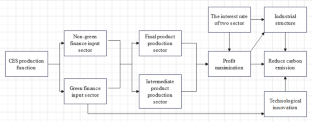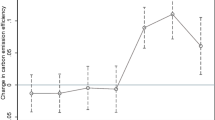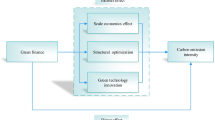Abstract
As an important way for China to achieve its dual-carbon goal, green finance has become the foundation for promoting high-quality economic development in China. In order to clarify the mechanism of green finance on carbon emissions, this paper puts green finance into the economic model and deduces the relationship between green finance and carbon emission reduction. This paper is based on the panel data of 30 provinces in China (excluding Tibet, Hong Kong, Macao, and Taiwan) from 2008 to 2019, using the individual fixed effect model, dynamical model, mediator model, and SDM model to study the impact of green finance on carbon emissions and its impact path of upgrading of the industrial structure and the development of science and technology based on the measurement of the green finance development index of each province by the entropy method. The findings show that the development of green finance can reduce carbon emission significantly, which can be sustained until at least the third phase and generates spatial spillover effects; regional heterogeneity analysis finds that the development of green finance shows geographical discrepancies: compared with the eastern and western regions, the development of green finance in central region can reduce carbon emissions more significantly; not only can the development of green finance directly reduce carbon emission, but also through the upgrading of industrial structure and technological innovation. The research not only provides a new perspective and supplementary empirical evidence for understanding the carbon emission reduction effect of green finance, but also offers some useful references for green finance to contribute to carbon emission reduction.




Similar content being viewed by others
Data availability statement
Not applicable.
References
Baron RM, Kenny DA (1986) The moderator-mediator variable distinction in social psychological research: conceptual, strategic, and statistical considerations. J Pers Soc Psychol 51(6):1173–1182
Chen XY (2020) Financial structure, technological innovation and carbon emission: on the development of green financial system. Guangdong Soc Sci 04:41–50
Chen X, Chen Z (2021) Can green finance development reduce carbon emissions? Empirical evidence from 30 Chinese provinces. Sustainability-Basel 13(21):12137
Deng Y (2022) Research on the Impact of Agricultural Green Technology Progress on Carbon Emissions. Tongfang CNKI (Beijing) Technology Co., Ltd. https://doi.org/10.27409/d.cnki.gxbnu.2022.000093
Ding J, Li ZF, Huang JB (2022) Can the green credit policy promote the green innovation in enterprises?—— Based on the perspective of policy effect differentiation. Financ Res 12:55–73
Gan C, Voda M (2023) Can green finance reduce carbon emission intensity? Mechanism and threshold effect. Environ Sci Pollut Res 30:640–653
Guo XY (2022) The influence mechanism and empirical test of green finance in boosting the transformation of low-carbon economy. South Finan 01:52–67
Huang Z (2023) Does green investment reduce carbon emissions? New evidence from partially linear functional-coefficient models. Heliyon 9:e19838
Khan MA, Riaz H, Ahmed M, Saeed A (2022) Does green finance really deliver what is expected? An Empirical Perspective. Borsa Istanb Rev 22(3):586–593
Krogstrup S, Oman W (2019) Macroeconomic and financial policies for climate change mitigation: A review of the literature.
Lee CC, Lee CC (2022) How does green finance affect green total factor productivity? Evidence from, China. Energy Econ 107:105863
Lei XD (2022) Research on the impact of green finance on economic low-carbon transformation and development. Tongfang CNKI (Beijing) Technology Co., Ltd. https://doi.org/10.27623/d.cnki.gzkyu.2022.000687
Li LY (2017) Analysis of inter-provincial total carbon emission efficiency and its influencing factors in China. Dongbei University of Finance and Economics
Lin BQ (2022) High-quality economic growth in China in the process of carbon neutrality. Econ Res 57(01):56–71
Lu J, Yan Y, Wang TX (2021) Research on the micro effect of green credit policy —— based on the perspective of technological innovation and resource reallocation. China’s Ind Econ 01:174–192
Lu H, Xu Y, Wang W, Zhao J, Li G, Tian M (2023) Can China reach the CO2 peak by 2030? A forecast perspective. Environ Sci Pollut Res 30(59):123497–123506
Nepal R, Zhao XM, Liu Y, Dong K (2024) Can green finance strengthen energy resilience? The case of China. Technol Forecast Soc Chang 202:123302
Pan DY, Chen CQ, Michael G (2021) Financial Policy and Economic Low-carbon Transformation —— Research based on the perspective of growth. Financ Res 12:1–19
Peng, Yan W, Elahi E (2022) Does the green credit policy affect the scale of corporate debt financing? Evidence from listed companies in heavy pollution industries in China. Environ Sci Pollut Res 29:755–767
Puspanjali B, Anasuya H, Narayan S (2023) Achieving carbon neutrality target in the emerging economies: role of renewable energy and green technology. Gondwana Res 121:16–32
Ran Q, Liu L, Razzaq A et al (2023) Does green finance improve carbon emission efficiency? Experimental evidence from China. Environ Sci Pollut Res 30:48288–48299
Rasoulinezhad E, Taghizadeh-Hesary F (2022) Role of green finance in improving energy efficiency and renewable energy development. Energ Effi 15:14
Shi DM, Shi XY (2022) Green finance and high-quality economic development: mechanism, characteristics and empirical research. Stat Study 39(01):31–48
Su DW, Lian L (2018) Does green credit affect the investment and financing behavior of heavily polluting enterprises? Financ Res 12:123–137
Sun SY, Wang XY, Gao CY (2023) Can green credit play a carbon emission reduction effect?. China’s Population. Resour Environ 33(08):37–47
Wang J, Ma Y (2022) How does green finance affect CO2 emissions? Heterogeneous and mediation effects analysis. Front Environ Sci 10:931086
Wang X, Wang Y (2021) Green credit policy promotes green innovation research. Manag World 37(06):173–188
Wang Y, Pan DY, Peng Y (2019) Research on green credit incentive Policy based on DSGE model. Financ Res 11:1–18
Wang QJ, Wang HJ, Chang CP (2022) Environmental performance, green finance and green innovation: what’s the long-run relationships among variables? Energ Econ 110:106004
Wang S, Xu J, Zhang W (2023) Research on the impact of green finance on China’s carbon neutralization capacity. Environ Sci Pollut Res 30:108330–108345
Wang LL, Yang XY, Cai QH (2024) Influence mechanism of green finance on regional emission reduction. Heliyon 10(1):e23861
Wen SY, Shi HM, Guo J (2022a) Research on the emission reduction effect of green finance from the perspective of general equilibrium theory: from model construction to empirical test. China Manag Sci 30(12):173–184
Wen WY, Liu H, Wang H (2022b) Green finance, green innovation, and high-quality economic development. Financ Res 08:1–17
Wen ZL, Ye BJ (2014) Mediating effect analysis: methods and model development. Adv Psychol Sci 22(05):731–745
Wu GL, Liu X, Cai YL (2024) The impact of green finance on carbon emission efficiency. Heliyon 10:e23803
Xu J, Chen F, Zhang W, Liu Y, Li T (2023) Analysis of the carbon emission reduction effect of Fintech and the transmission channel of green finance. Financ Res Lett 56:104127
Yan CL, Li T, Lan W (2016) Financial development, innovation, and carbon dioxide emissions. Financ Res 01:14–30
Yin ZM, Sun XQ, Xing MY (2021) Study on the influence of green finance development on green total factor productivity. Stat Decis-Making 37(03):139–144
Yu CH, Wu X, Zhang D, Chen S, Zhao J (2021) Demand for green finance: resolving financing constraints on green innovation in China. Energy Policy 153:112255
Zhang J, Jiang HQ, Liu GY, Zeng WH (2018) A study on the contribution of industrial restructuring to reduction of carbon emissions in China during the five Five-Year Plan periods. J Clean Prod 176:629–635
Zhang W, Zhu Z, Liu X (2022) Can green finance improve carbon emission efficiency? Environ Sci Pollut Res 29:68976–68989
Zhu B, Zhang TL (2021) The impact of cross-region industrial structure optimization on economy, carbon emissions and energy consumption: a case of the Yangtze River Delta. Sci Total Environ 778:146089
Funding
This paper is funded in accordance with the China Association for Science and Technology for the 2022 Graduate Science Popularization Ability Improvement Project (KXYJS2022064) Jiangsu Provincial Postgraduate Practice Innovation Program (KYCX23_1097).
Yizhi Chen thanks the China Association for Science and Technology for the 2022 Graduate Science Popularization Ability Improvement Project (KXYJS2022064) Jiangsu Provincial Postgraduate Practice Innovation Program (KYCX23_1097) for its support.
Author information
Authors and Affiliations
Contributions
Author 1 (first author): Peifeng Jiang. PF contributed to the conceptualization, methodology, design, theoretical model derivation, and data analysis of the study and was a major contributor in writing the manuscript.
Author 2: Chaomin Xu. CX contributed to the investigation, former analysis, data analysis, validation, and writing of the study.
Author 3 (corresponding author): Yizhi Chen. YC contributed to the project administration, supervision, revising, and editing of the study.
All authors read and approved the final manuscript.
Corresponding author
Ethics declarations
Ethics statement
No conflict of ethics.
Conceptualization
Under the background of the increasingly serious problem of carbon emissions, how China achieves “carbon peak” and “carbon neutrality” shows its pursuit of high-quality economic development and its responsibility of a major country. In addition, whether China can achieve “carbon peak” and “carbon neutrality” will significantly affect the global carbon reduction action. But there are few theoretical research on carbon emission and green finance. So this paper attempts to construct an economic model of green finance and carbon emission.
Methodology
This paper uses the individual fixed effect model, dynamical model, mediator model, and SDM model to study the impact of green finance on carbon emissions and its impact path of upgrading of the industrial structure and the development of science and technology.
Software
The data processing, modeling analysis, and plotting in this paper were carried out using Excel and Stata.
Consent to participate
Not applicable.
Consent for publication
Not applicable.
Author statement
The manuscript describes original work and is not under consideration by any other journal. All authors have approved the manuscript that is enclosed.
Competing interests
The authors declare no competing interests.
Additional information
Responsible Editor: Eyup Dogan
Publisher's Note
Springer Nature remains neutral with regard to jurisdictional claims in published maps and institutional affiliations.
Rights and permissions
Springer Nature or its licensor (e.g. a society or other partner) holds exclusive rights to this article under a publishing agreement with the author(s) or other rightsholder(s); author self-archiving of the accepted manuscript version of this article is solely governed by the terms of such publishing agreement and applicable law.
About this article
Cite this article
Jiang, P., Xu, C. & Chen, Y. Can green finance reduce carbon emission? A theoretical analysis and empirical evidence from China. Environ Sci Pollut Res (2024). https://doi.org/10.1007/s11356-024-33572-8
Received:
Accepted:
Published:
DOI: https://doi.org/10.1007/s11356-024-33572-8




